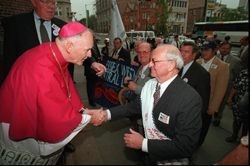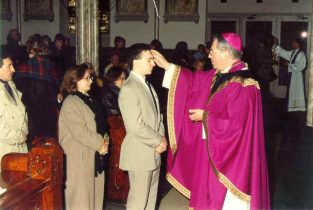After Msgr. Maloney’s death, continuity was assured as Archbishop Theodore E. McCarrick, who had succeeded Archbishop Gerety in 1986, appointed Rev. Neil Mahoney as pastor in 1990. Father Neil was a familiar face as he had resided at St. Patrick’s since 1984.
Bordered by the business community on one side and the university community on the other, St. Patrick’s continued an active parish life. There were approximately 300 families in the parish, predominantly from Latin America. Rev. Guillermo Arias directed the Hispanic Apostolate. Father Arias resided at St. Patrick’s and was available to the people during the week as well. The Sunday Mass in Spanish was organized by the parishioners and was a joy-filled celebration enhanced with music directed by guitarist Ramon Padilla. Padilla, Gloria Rosada, Carmen Pate, and Evelyn De Jesus coordinated the liturgy. After Mass everyone gathered in the school hall for coffee, tea, cakes, cookies, and other refreshments. Hospitality, arranged by Candida Morales, provided an opportunity for informal fellowship and recreation. Rev. Roberto Paiz, who came to the parish from Elizabeth, often celebrated this Mass and remained to participate in the community gathering afterward. His presence gave parishioners opportunity to participate in the Sacrament of Reconciliation and to obtain pastoral counseling.
While many priests have devoted their lives to the Latino community of St. Patrick’s, one is remembered with special love. Rev. Paul Viale served the community for four short years from 1993 to 1997. He learned Spanish quickly, working hard to be able to communicate and to understand. He would ask parishioners to write down anything he said incorrectly and correct his mistakes. His homilies were directed to all but especially to the youth. When he died of cancer in 1998, a parishioner remarked that he “walked in the sandals of Jesus. Father Paul loved sandals. Like Jesus he came to serve, was crucified, died, and was resurrected.”
Parish societies continued to provide a variety of opportunities for spiritual growth. A weekly prayer meeting began with the Rosary and included praise and thanksgiving and scripture sharing. On the First Friday of every month, Deacon Vicente Rodriguez presided at the Exposition of the Most Blessed Sacrament. At its monthly meeting, the Sacred Heart Society continues the devotion that was instituted in the parish over a century ago by Bishop Corrigan. Every November a festive Mass and celebration honored Our Lady of Divine Providence, Patroness of Puerto Rico. The floral arrangements that surrounded the statue of Our Lady on this occasion are truly magnificent. The Novena to the Infant Jesus occupied the nine days before Christmas and drew a large number of people.

Courtesy of The Star Ledger
The Hispanic Apostolate organized visits to the homes of parishioners to say the Rosary. During these visits, prayers were offered over the sick and anyone else who asked for prayer and spiritual assistance. The apostolate also arranged for the Eucharist to be brought to anyone who was homebound. Each October a Family Dinner was held in the school auditorium, giving an opportunity to renew acquaintances and welcome newcomers.
St. Patrick’s once was the site of two schools and an orphanage. That tradition of service continued. The parish leased the school and other buildings to Catholic Community Services which conducted a School of Special Education, a Center for AIDS, and a Child Care Center. This also provided needed income to the parish. Ministry to the disadvantaged and the poor, a tradition of the pro-cathedral since its inception, continued. Every weekday more than 100 lunches were served. Each Thursday a hot meal was provided to over 200 seniors and women with children in the school auditorium. These activities were coordinated by Peter Scavuzzo with the help of volunteers from St. John’s Parish in Clark, the Knights of Columbus of Westwood and of Clark, St. Catherine of Siena Parish in Cedar Grove, Our Lady Mother of the Church Parish in Woodcliff Lake, and Oratory Catholic Preparatory School in Summit. Canned goods are distributed on Tuesday, Wednesday, and Thursday with the help of volunteers Michael Walsh, Al Ahearn, and Peter Borghese. These efforts brought together people from many parishes throughout the archdiocese of Newark. Coming together at the “Old Cathedral” of the archdiocese, they continued a tradition of service that began in 1850.

Courtesy of The Catholic Advocate
Other traditions continued. At Ash Wednesday services and on other occasions, Archbishop John J. Myers, who succeeded Archbishop McCarrick in 2001, presided from Jelliff’s magnificent cathedra as did his predecessors. The St. Patrick’s Day Parade returned to Newark from the suburbs and once again passed near its portals. The Irish struggle for freedom was recalled every Easter Sunday as the skirl of bagpipes filled St. Patrick’s Pro-Cathedral, the Proclamation of Irish Independence is read, and prayers are offered for the martyrs of the Easter Rebellion. The annual Labor Day Mass, sponsored by the Essex-West Hudson Labor Council AFL-CIO, recalled the struggles of the 19th century immigrant to achieve a just wage, and reminded the community of the rights of workers and the continuing struggle for justice in our society. The sacrifices of “Newark’s Bravest” were recognized each year as the Firehouse Bell tolled in St. Patrick’s at the annual Mass of the Newark Fire Department Holy Name Society.

Courtesy of The Star Ledger
In 1999 and 2000, Monsignor Mahoney directed extensive renovations and restoration of the pro-cathedral. The work was long overdue. Early one morning, about 2:00 a.m., as the restoration was in progress, a windstorm blew down the heavy cross from atop the spire. “I didn’t hear a thing,” Mahoney told reporters, “it was a blessing nobody was beneath it.” The stainless steel cross, St. Patrick’s third, had been installed in 1946. Mahoney replaced it with a copper cross to match the type shown in early engravings of the church. Since the building is a state, as well as a national, historic site, the cost of exterior repairs was shared by the archdiocese of Newark and the state of New Jersey. The roof was repaired and leaks that had plagued the building for years were sealed. The brickwork was “pointed” and sealed, the brownstone was restored. Pigeons were evicted from their comfortable perches amidst the cathedral’s long-silent bells. Inside the church was restored to its former glory. Light once again shone through its magnificent stained glass. The details of paintings re-appeared from the gloom of years of grime. The faces of sculpted angels and saints gaze in golden splendor. Gothic pillars and tracery, graced with gilded capitols, once again show forth the grace of Patrick Keely’s design and Father Moran’s vision. The sanctuary takes on new magnificence as the Blessed Sacrament is restored to prominence in a bronze Gothic tabernacle set before a marble background on the old altar. In the center of the sanctuary a new marble altar is the central focus of the church, the place of the Eucharistic celebration, the very reason the Catholics of Newark built this noble edifice. In 2002, a new marble baptismal font was placed in the nave, a generous gift from Father Joseph Quinlan, a former curate.